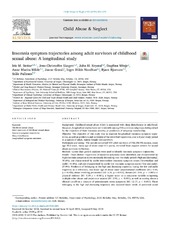| dc.Published | Steine IM, Skogen JC, Krystal JH, Winje D, Milde AMM, Grønli J, Nordhus IH, Bjorvatn B, Pallesen S. Insomnia symptom trajectories among adult survivors of childhood sexual abuse: A longitudinal study. International Journal of Child Abuse & Neglect. 2019;93:263-276 | eng |
| dc.description.abstract | Background: Childhood sexual abuse (CSA) is associated with sleep disturbances in adulthood. However, longitudinal studies have yet to identify among CSA-survivors subgroups distinguished by the trajectory of their insomnia severity, or predictors of subgroup membership. Objective: The objective of this study was to examine longitudinal insomnia symptom trajectories, as well as predictors and correlates of the identified trajectories, over a 4 year study period in a sample of adult, mainly female CSA-survivors. Participants and setting: The sample comprised 533 adult survivors of CSA (94.9% women, mean age 39.2 years, mean age of abuse onset 6.5 years), recruited from support centers for sexual abuse survivors in Norway. Methods: Latent class growth analyses were used to identify insomnia symptom trajectories. Results: Three distinct trajectories of insomnia symptoms were identified; one characterized by high insomnia symptom scores minimally decreasing over the study period (‘high and decreasing’, 30.6%), one characterized by stable intermediate insomnia symptom scores (‘intermediate and stable’, 41.5%), and one characterized by stable low insomnia symptom scores (‘low and stable’, 27.9%). Predictors of belonging to the high and decreasing trajectory (using the low and stable trajectory as a reference), was lower age of abuse onset (expotentiated coefficient (EC): 0.93, p = 0.026), abuse involving penetration (EC: 2.36, p = 0.005), threats (EC: 3.06, p < 0.001) or physical violence (EC: 3.29 p < 0.001), a higher score on a composite variable comprising multiple other abuse and perpetrator aspects (EC: 2.55, p < 0.001), as well as scoring above a clinical cut-off on a measure of posttraumatic stress symptoms (EC: 12.17, p < 0.001). Those belonging to the high and decreasing trajectory also reported lower levels of perceived social support and higher levels of subjectively experienced relational difficulties compared to those belonging to the two other trajectories. Conclusions: We conclude that different longitudinal insomnia trajectories exist among adult CSA survivors. The overall results, as well as the significant predictors, are discussed alongside their potential clinical implications. | en_US |

